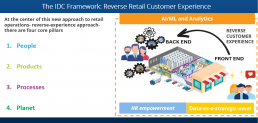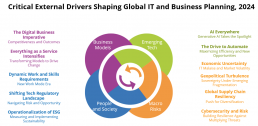Future-proofing Virtual Care: A Three-step Approach
Virtual care is at a critical juncture in its development. The rapid rise of virtual care during the pandemic sparked discussions about its ongoing significance. While numerous studies have highlighted its advantages, the future of virtual care is now under scrutiny.
As the novelty effect fades, both healthcare professionals and patients are redefining their expectations and preferences, leading to valid questions about the path ahead for virtual care.
What is Virtual Care?
Definition in this space abounds, but from a general perspective, virtual care encompasses all the remote interactions between healthcare organizations and patients, enabled by digital tools to deliver health services, promote engagement and enhance health and well-being. It includes services and organizations focused on patient education and advice but also services that entail diagnosis, monitoring and treatment.
There is a broad spectrum of technologies enabling virtual care, covering connectivity, collaboration, clinical information systems, consumer technologies, MedTech, etc. These components enable communication, data exchange and analysis, transforming how healthcare is delivered and experienced.
Main Benefits and Limitations of Virtual Care
The adoption of virtual care in European healthcare systems has triggered profound shifts and delivered benefits across multiple dimensions It has brought about notable improvements at the system level, as well as advancements within healthcare organizations. Virtual care has had a positive impact on patient outcomes and experiences, underscoring its significance in shaping the future of healthcare.
According to IDC’s December 2022 Consumer Pulse Survey, healthcare consumers reported comparable satisfaction levels with virtual visits as they did with traditional in-person appointments. When focusing on some macro-level benefits, virtual care has shown its pivotal role in healthcare by relieving ER pressure, freeing beds for patients with more critical needs, and improving operational efficiency.
For example, the English NHS recently surpassed its goal’s target of 10,000 virtual ward beds by September 2023. These beds cater to patients with conditions like COPD, heart failure, and frailty. Over 240,000 patients have been treated through virtual wards, with research suggesting comparable or faster recovery compared to traditional hospital care.
However, it is crucial for healthcare providers to acknowledge that virtual care is not without limitations and challenges, which must be carefully addressed. Without these considerations, healthcare organizations will struggle to realize the anticipated benefits, and, in some cases, they could even compromise care quality.
- Transforming Essential Care – If We Connect the Dots: Virtual care offers convenience by allowing patients to access non-urgent medical services from home. It can alleviate strain on emergency rooms, address primary care shortages, and extend services to underserved areas. However, integration into patient records is essential for continuity of care. Technical obstacles, especially in underserved regions, require further investments in infrastructures, health information data integration and management.
- Empowering Chronic Disease Management – If We Use the Right Tools: Virtual care positively impacts chronic disease management, but it requires appropriate engagement tools. Choosing ergonomic device design, automated real-time data collection, performance criteria (speed, accuracy, response times), and diverse functionalities (like medication reminders, predictive alerts) significantly impact the outcomes for virtual care. Striking a balance between virtual care benefits and the need for in-person assessments is vital. Understanding which aspects of disease management can be handled remotely, and which require in-person attention due to physical exams and specialized tests, is essential for comprehensive care.
- Tackling Health Inequalities – If We Mind the Digital Gap: Virtual care aims to bridge healthcare access gaps, but the digital divide and limited digital literacy pose barriers. Health inequalities persist, with evidence of disparities in digital technology utilization. IDC research shows that the primary user demographic of virtual visits are young, urban, higher-income individuals, typically facing fewer access barriers. To tackle these disparities, virtual care solutions need to be intentionally designed to address specific barriers faced by different patient groups.
How to Future-Proof Virtual Care
Virtual care holds the potential to improve healthcare accessibility and delivery by providing care to individuals regardless of their location or the time of day. To fully harness this potential, it is crucial to thoughtfully address the challenges and shortcomings it currently faces and implement long-term strategies that facilitate transformative changes.
- Assess Population Needs: Understand diverse patient requirements, including digital literacy and social determinants of health (SDoH). Embrace “hybrid care” models that offer both virtual and in-person options, catering to individual needs.
- Choose Appropriate Technology: Select medical-grade remote patient monitoring devices and platforms that integrate seamlessly with healthcare professionals’ workflows. Ensure active patient engagement.
- Establish a Virtual Care Ecosystem: Foster collaborations among healthcare authorities, provider organizations, and life science companies. Implement suitable reimbursement schemes to incentivize healthcare providers for round-the-clock virtual care availability.
At IDC we have just published a report “ IDC Innovators: Remote Patient Engagement and Virtual Care Solutions, 2023” exploring how emerging technology vendors are supporting the evolution of virtual care working with healthcare organizations and the broader health ecosystem.
Virtual care should not be seen just as a legacy of the pandemic-era; instead, it stands as a transformative force shaping the future of healthcare. By aligning with population needs, leveraging technology sensibly, and fostering collaboration in the healthcare ecosystem, virtual care can advance even further. Its role in delivering high-quality, accessible, and convenient healthcare services tailored to individuals worldwide will remain pivotal.
As we transitioned into a post-pandemic era, it’s crucial to fine-tune virtual care programs to fit population-specific needs and integrate them seamlessly into the broader healthcare ecosystem, solidifying their significance.
If you’re curious and want to dive deeper into this subject, consider reaching out to our IDC Health Insights team. Also be sure to check the latest research on virtual care from Nino Giguashvili, Federico Mayr and Silvia Piai
AI in Retail: Enabling Purpose and Innovation
“Having a purpose is more than just a statement. It should be the glue that binds everyone together in the pursuit of success. Purpose should be the guiding principle that shapes every aspect of an organization. It should be reflected in the design of products, the management of supply chains, the employee experience, the customer journey, and the relationships within the broader ecosystem.” Roberta Bigliani, Group VP, Head of Insights, IDC EMEA.
Retailers need to balance priorities to achieve a successful customer-led retail strategy. To do so, they should begin with a purpose in mind and define roles within the organization to achieve that common purpose. Customer and employee experience are among the top priorities for digital transformation among European retailers, according to the IDC Global Retail Survey, 2023. Retailers should focus on the four Ps (People, Product, Processes, Planet) of the reverse retail experience to address customer expectations and employee experience, speed up time to market, manage value chain interactions, and ensure sustainable operations.
IDC’s Reverse Experience for Customer-Led Retail
A possible strategy for CDOs is to identify key stakeholders within the organization, define strategic themes for digital transformation, get rid of silos within the organization, and reconcile the digital strategy with company culture. To support personalized and omnichannel customer journeys, retailers should leverage the right tools to integrate the four pillars through strategic planning with a long-term vision.
AI is emerging as a key tool for companies to act on their purpose, pursue strategic priorities, and enable innovation. Here below a few examples of how AI is transforming Retail:
- Generative AI for Enhanced Customer Service. Retailers can use Generative AI to generate high-quality content that meets the needs and expectations of their customers, while also reducing costs.
One of the common use cases in retail is order tracking, where customers can contact virtual agents (bots) through various channels (phone, chat, social media) to check the status of their orders.
Generative AI is transforming customer service by allowing human agents to focus on the issues that require their attention. According to industry sources, the bots can handle 80% of the cases without escalating them to human agents, which means faster and more efficient service for the customers.
- Responsible AI for Customer Trust. AI is shaping how companies communicate with customers and the extent to which they meet their expectations. Good intentions are often not good enough with AI, and the use of AI must be done responsibly with respect for human values and ethical principles.
So what can companies do to use AI responsibly? Setting out AI principles, including accountability, privacy, sustainability, safety, and inclusivity, that are applied whenever AI is used, can be a winning approach. AI trustworthiness must be ensured at each step of the customer journey to build lasting relationships with their customers.
- AI for Empowered Store Associate. AI/ML can support store associates in becoming more effective in their interaction with the customer through greater access to customer information, enabling better recommendations and offers to each customer, and increasing their satisfaction and loyalty.
Crucially AI can also simplify the life of the customer in-store, by offering them tools and features that enhance their shopping experience. For example, a leading European home improvement retailer uses mobile app gamification to prepare the shopper for the store visit, making it a more relevant and effective use of their time.
Through AI, the store associate can become more than a salesperson, but a trusted advisor and partner for the customer, who can deliver value, trust, and loyalty.
- AI for the Future of Retail. The future of retail is not only about adopting digital tools but also about transforming the mindset and culture of the organization. Retailers need to build a mindset of continuous transformation.
AI is changing the productivity paradox, speeding it up. AI, Generative AI, and advanced algorithms, applied to the whole retail business operations and functions, will enable companies to make high-volume and real-time decisions, with surgical precision, but only if supported by a comprehensive data management strategy.
Immersive experience tech, such as the Metaverse, Web3, 3D product visualization, AR/VR, and XR, will also have a role in the future of the industry because they will enable retailers to overcome the limits of traditional retail and bridge the gap between physical and digital shopping.
The impact of AI on Retail was front and center of the talks during the IDC Retail Xchange 2023, which focused on the importance of purpose as the key element to shape the Reverse Experience for Customer-Led Retail.
For the two-day event, held on September 18 and 19, executives from global retail, CPG, and technology organizations gathered in a magnificent country manor house at Amsterdam’s doorstep to engage in speaking sessions, fireside chats, roundtables, and Q&As.
Thanks to all the participants that made this year’s event a success!
You can subscribe to IDC Retail Insights: Worldwide Retail Customer Experience Strategies and IDC Retail Insights: Worldwide Retail Commerce and Direct-to-Consumer Strategies for more in-depth coverage of the IDC Retail Xchange 2023, and more analysis on topics and trends shaping customer experience and commerce in today’s retail and consumer goods, and access to IDC Retail Insights analysts’ expertise.
Sustainable Manufacturing: Key Priorities in EMEA
Manufacturers worldwide are embracing sustainability as the new imperative and becoming a force for good. Recent regulatory developments in Europe including proposed regulation to curb greenwashing and incorporate eco-design for sustainable products, as well as a recently enacted law for sustainable battery production and recycling are just examples highlighting the need for manufacturers to step up their game in sustainability.
Moving beyond compliance and reporting requirements, manufacturers are embedding sustainability into their operations to increase efficiency, reduce their environmental footprint and create long-term value for their partners and customers. According to IDC Global Sustainability Readiness Survey (August 2023), 45% of EMEA manufacturers state that the sustainability related requirements from their business partners are the top driver for operationalizing sustainability, followed by mitigating risks associated with non-sustainable operations, and improving brand reputation.
By producing eco-friendly products and sustainable business models that appeal to their consumers, manufacturers can drive their bottom line and gain competitive advantage.
Based on IDC’s 2023 Global Manufacturing Survey (January 2023) which surveyed 430 EMEA manufacturers, incorporating circular economy principles (i.e. using fewer and renewable materials and designing products that can be easily recycled, repaired, or remanufactured) is the top initiative for 57% of EMEA manufacturers to promote sustainability.
Tracking emissions across the value chain is another key initiative which includes analyzing the carbon footprint from production and exchanging data with suppliers, customers, and other stakeholders. Manufacturers are also investing to reduce waste and drive efficiencies in production including optimizing energy usage.
Manufacturers Priorities in EMEA
Design for Circularity
Designing for circularity focuses on creating products that can be easily disassembled, recycled, and remanufactured at the end of their life cycle. To achieve this, manufacturers rely on resource tracking, materials innovation, reverse supply chain management and advanced recycling methods.
Generative design also enables manufacturers to iteratively create efficient and sustainable product designs that minimize waste and maximize products’ lifespan. Additionally, advanced simulation software can allow virtual product testing, allowing manufacturers to test products with fewer resources while generating less emissions.
Real-time Energy Monitoring and Optimization
Continuous monitoring of energy consumption levels allows manufacturers to have visibility into their energy usage patterns, identify areas of improvement, and optimize their energy consumption. This process leverages sensors, IoT and data analytics platforms to collect and analyze energy data in real-time.
IDC’s Global Sustainability Readiness Survey shows that 52% of EMEA manufacturers are using sensors and smart meters to gain real time visibility into carbon footprint.
Tracking and Tracing Emissions in the Product Lifecycle
Monitoring and identifying emissions sources and quantities throughout a product’s life cycle can significantly reduce its carbon footprint, as Scope 3 emissions can constitute a significant portion of total life cycle emissions. This can be achieved through advanced data analytics, sensors, and internet of things (IoT) devices that collect and analyze emissions data in real-time.
Additionally, blockchain technology can be utilized to create a transparent record of emissions data, ensuring accuracy and accountability throughout the value chain.
The Road Ahead
Going forward, digital technologies will continue to be instrumental in driving sustainability. Crucially, manufacturers will need to focus on new ways of capturing and analyzing data from multiple sources to gain actionable insights on their sustainability performance.
Generative AI holds promise in synthesizing and analyzing highly fragmented sources for ESG data as well as complex regulations to ensure compliance while making informed decisions.
Despite the promise of sustainable manufacturing, there are several challenges to address. Driving sustainability will require a company-wide agreement and a cultural shift among the C-suite and stakeholders.
Outside the company boundaries, this also requires concerted effort with partners and suppliers and entails encouraging them to be more sustainable by making sustainability credentials an important criteria in the supplier selection process. Furthermore, best in class manufacturers have a clear strategy in place and acknowledge that sustainability is not a one-off stunt but rather a continuous and transformational process to improve their operations and business models.
The true challenge is how to move beyond pilots and truly operationalize sustainability at scale and make a real impact in driving a sustainable future.
To find out more about sustainability in manufacturing, please visit our website.
ICT Market Predictions in the Making — IDC EMEA FutureScape 2024
Fall traditionally means Predictions time for the entire IDC community. That point of the year where we gather across different research domains to reflect on those trends steering organizations’ digital agendas and predict what will characterize the digital landscape in the months and years to come.
This year, this is happening at the dawn of a new chapter in the Digital Business Era: the chapter of AI Everywhere.
Generative AI triggered the opening of this chapter because it holds the potential to drastically reduce the time and long-term costs associated with developing solutions across a wide range of use cases associated with automation and intelligence. It is completely changing our relationship with data and how we extract value from both structured and unstructured data.
This era is about how we use data as input and as a business outcome:
- 18% of EMEA organizations believe that GenAI is already disrupting their business, and 70% of all organizations believe it will do so in the next 18 months.
- 44% of EMEA organizations are already investing in GenAI or doing initial model testing and proofs of concepts.
- Customer-facing applications, financial and operational decision support applications, and employee experience applications are sweet spots for GenAI integration.
- GenAI is expected to capture 15% of EMEA organizations’ new IT projects budgets in 2024, representing a must-have chevron in technology vendors capabilities and portfolios (IDC GenAI ARC Survey, August 2023 — GenAI Awareness, Readiness, and Commitment: A First Look at IT Leaders’ Expectations and Concerns for Generative AI).
For organizations to gain a competitive edge in this new era, a full reimagination is needed.
Creating an intelligent architecture that is supported by a cost-effective digital infrastructure and relevant capabilities is a priority. At the same time, this journey raises ethical and trust-related questions that purpose-driven organizations must prepare for.
AI Everywhere is certainly the key factor altering the global business and digital ecosystem for the next 12-24 months and beyond, but other critical external drivers will also shake 2024:
- The Drive to Automate
- Economic Uncertainty
- Geopolitical Turbulence
- Global Supply Chain Resiliency
- Cybersecurity and Risk
- The Digital Business Imperative
- Everything as a Service Intensification
- Dynamic Work and Skills
- Shifting Tech Regulatory Landscape
- Operationalization of ESG
This year’s unveiling of IDC’s EMEA Predictions for 2024 and will take place on December 11. In the weeks leading up to the reveal, we will release a series of thought leaderships assets that will double-click on these key drivers, analyzing their digital impact and highlighting actions that organizations will have to take to be Digital Future ready (the partial list of upcoming webcasts with registration links can be found below).
In the meantime, if you want to remain updated on the upcoming releases, please visit our IDC European FutureScape page, and register to join us for the IDC EMEA Futurescape 2024 webcast.
Upcoming October and November IDC EMEA webcasts you can register for:
Premium Device Sales Soaring: Navigating Inflation and Consumer Trends
Five Ways to Unlock a Purposeful, Automated Future of Work in EMEA
Driving a digital advantage with intelligent infrastructure management in EMEA
The Cloud-Centric World: Strategies for Service Providers to Drive Differentiation
Sustainability in EMEA: The Challenge of Moving from Ambition to Action
Embracing Tomorrow: Your Roadmap to Emerging Technologies in EMEA
















